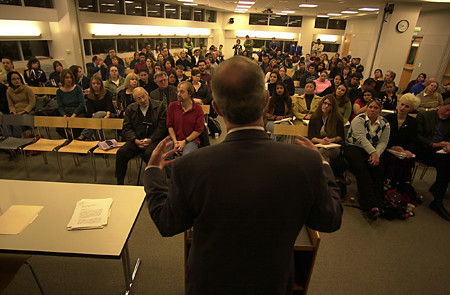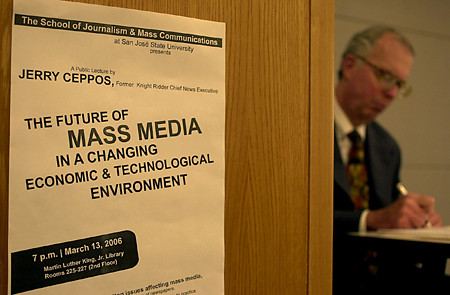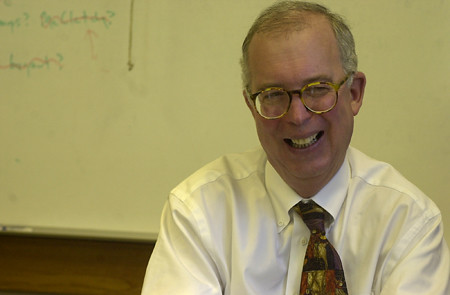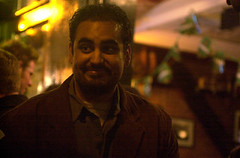Old skooler, Ceppos speaks of the future of media
Former Executive Editor of the San Jose Mercury News, Jerry Ceppos spoke to San Jose State University students in a talk entitled “The future of mass media in a changing economic and technological environment,” a discussion about the future of the news and how people get the news.
Ceppos spoke to a nearly packed audience, which according to he Spartan Daily numbered in the vicinity of 200, and the audience was very responsive.
 I attended his presentation and much of what he was saying agreed with me. As the current online editor of the Spartan Daily I knew that what he was saying is exactly where we need to be headed.
I attended his presentation and much of what he was saying agreed with me. As the current online editor of the Spartan Daily I knew that what he was saying is exactly where we need to be headed.
Ceppos introduced the state of newspapers with some startling figures: between 1994 to 2004 newspaper circulation has gone down eight percent and 4.7 million papers have disappeared. Readership has fallen as well, 39 percent among 18 to 34 year-olds and 70 percent among 65+ year-olds. The bread and butter of a newspaper, ad revenue and classified listing, has also been on a steady decline.
As this tread continues, it doesn’t look good for the future, but Ceppos points to the web as a new medium for newspapers to exploit, and if history has taught us anything, it’s that everything changes and innovation fuels the industry. When “the wire” was introduced, it changed the news and the technology made it possible to give the people news faster. When advertisers became a viable revenue source, newspapers started to become more journalistic. Meaning that the removal of the reliance of political favor for production costs paved the way for the watch dog role and paid journalist. When magazines started using color, newspapers quickly realized that this was the sign of the times and it was time to change or be left behind.
While print numbers are falling, the numbers on the web are promising: Web revenue is up 54.5 percent in one year. And more people are accessing the web every year, from 18 percent in 1997 to 54.7 percent in 2003.
Ceppos then asked how many of us read a newspaper, and out of our nearly packed room of Journalism majors, only half of the attendees raised their hand as readers. Immediately he posed this question, “how can we save newspapers,” he said.

The crowd offered up various suggestions and a trend emerged. Many of the ones offering up suggestions were centering their ideas around technology and making use of the web.
The ideas ranged from the simple: RSS feeds to personalized news according to reader interests. To the bold, such as creating a new newspaper targeted at a younger audience and run by a younger audience.
Everything being suggested I jotted down. As the online editor, I was using the opportunity of hearing what students wanted as my own personal focus group.
In brief, here’s a few points the group brought up along with some of my remarks in parentheses:
As a prime example for how the media can use the web to its advantage, Ceppos brought up the Muslim cartoon controversy. Many papers were having trouble trying to figure out how to deal with talking about the cartoon and weather they should reprint it for readers. Some did reprint it and some did not for fear of offending others. What as far as anyone in the room was not able to cite an example of was a newspaper using the web to publish the cartoon. This scenario makes it possible to only let those people who want to see the cartoon see it and at the same time avoids any controversy in the print version. In print a paper would only use words to describe the cartoon and a blurb would be placed in the article to go to the website of the paper to see the cartoon. Makes sense to me.
After all the tech talk, Ceppos was careful to also make another very important point. It wasn’t all about the delivery or the new ways of making news, Ceppos kept it simple and went back the foundation. He summed up his ideas in two rules: write better and use the technology out there. Yet again he re-iterated his commitment to the web.
“If I was exec right now, I’d devote half my staff to online,” Ceppos said. Just look at the numbers, it makes sense to go more online since that’s where the readers are. If I can see it and Ceppos can see it, why isn’t it happening?
As of now the San Jose Mercury News has two full time online staffers and 250 staffers for the print edition. “Does that make any sense? No,” said Ceppos, “I would take 100 people and try to make the best online website in the world… maybe even charge for it.” That sounds like a viable future to me.
Overall I enjoyed Ceppos presentation, even if it seemed more of a back and forth rather than a structured presentation. I’ve heard many people disagree with his style, some saying they felt exploited. Some have said he did not really present anything new or actually talk about the subject of his talk’s title. Some have expressed that it seemed like he had nothing to say and all the ideas were coming from the audience.

It is true that he did ask and take a lot from the audience, with the majority of his time devoted to quarrying us for ideas that he would write on the white board. It may seem like this is all he was doing, but that’s not a very accurate conclusion.
Ceppos was asking us for ideas, but he was also commenting on those ideas, discussing those ideas, and reflecting on his newspaper past and discussing how what we are suggesting would fit into the future of media and how it can be used in newspapers. More importantly he discussed how all the things we were suggesting are doable and then tried to explain why it is not being done.
I liked his approach. I personally don’t like the dry behind the podium one-sided “talk at you” speakers that come through SJSU every week, and during my time as a photographer on the Spartan Daily I covered more than my share of these. Ceppos tried to get the crowd actively involved with the discussion and that is perfectly in keeping with the ideas he was trying to get across.
The future of media and newspapers is like Ceppos speech. An interactive, “talk with you” ever-evolving, changing on the fly according you your feedback, revolutionary in delivery, and unique take on a classic traditional style.
I have a feeling that the loose nature of his discussion is a product of his environment. It makes perfect sense to ask journalism majors what they think is the future of mass media. I’d be interested in attending his public lectures on March 13 and March 30, to see how he approaches the subject with a non-journalistic audience. It stands to reason that the public presentations would not be run the same way.
*Not enough Ceppos for you? Read all about Ceppos' Critique of the Spartan Daily.
Ceppos spoke to a nearly packed audience, which according to he Spartan Daily numbered in the vicinity of 200, and the audience was very responsive.
 I attended his presentation and much of what he was saying agreed with me. As the current online editor of the Spartan Daily I knew that what he was saying is exactly where we need to be headed.
I attended his presentation and much of what he was saying agreed with me. As the current online editor of the Spartan Daily I knew that what he was saying is exactly where we need to be headed.Ceppos introduced the state of newspapers with some startling figures: between 1994 to 2004 newspaper circulation has gone down eight percent and 4.7 million papers have disappeared. Readership has fallen as well, 39 percent among 18 to 34 year-olds and 70 percent among 65+ year-olds. The bread and butter of a newspaper, ad revenue and classified listing, has also been on a steady decline.
As this tread continues, it doesn’t look good for the future, but Ceppos points to the web as a new medium for newspapers to exploit, and if history has taught us anything, it’s that everything changes and innovation fuels the industry. When “the wire” was introduced, it changed the news and the technology made it possible to give the people news faster. When advertisers became a viable revenue source, newspapers started to become more journalistic. Meaning that the removal of the reliance of political favor for production costs paved the way for the watch dog role and paid journalist. When magazines started using color, newspapers quickly realized that this was the sign of the times and it was time to change or be left behind.
While print numbers are falling, the numbers on the web are promising: Web revenue is up 54.5 percent in one year. And more people are accessing the web every year, from 18 percent in 1997 to 54.7 percent in 2003.
Ceppos then asked how many of us read a newspaper, and out of our nearly packed room of Journalism majors, only half of the attendees raised their hand as readers. Immediately he posed this question, “how can we save newspapers,” he said.

The crowd offered up various suggestions and a trend emerged. Many of the ones offering up suggestions were centering their ideas around technology and making use of the web.
The ideas ranged from the simple: RSS feeds to personalized news according to reader interests. To the bold, such as creating a new newspaper targeted at a younger audience and run by a younger audience.
Everything being suggested I jotted down. As the online editor, I was using the opportunity of hearing what students wanted as my own personal focus group.
In brief, here’s a few points the group brought up along with some of my remarks in parentheses:
- Outreach programs that require sixth though eleventh graders to read the newspaper. The aim being to get them in the habit of being informed and realize just how important it is.
- Add new sections to draw in younger readers, such as the recent success of a videogame section on Saturdays. (I suggested this to the Mercury News in 2001, but I’m not bitter.)
- Create a stronger web presence and promote it so people are aware of it. (Promote it, what a concept!)
- Aim for a younger audience. (Perhaps by hiring younger people to management positions?)
- Update news online as it happens, throw on pictures and footage as it comes in.
- Offer Podcasts. (How about a digest of the news for people on the go?)
- Change the name, don’t call it a newspaper.
- Edgier news. (Perhaps a team of columnist and writers in a more magazine style section? I believe the San Francisco Chronicle has proven this can work with SFGate.)
- Re-design the paper to be more graphic. (Anything that mean more work for photojournalist is fine with me!)
- Print in foreign languages.
As a prime example for how the media can use the web to its advantage, Ceppos brought up the Muslim cartoon controversy. Many papers were having trouble trying to figure out how to deal with talking about the cartoon and weather they should reprint it for readers. Some did reprint it and some did not for fear of offending others. What as far as anyone in the room was not able to cite an example of was a newspaper using the web to publish the cartoon. This scenario makes it possible to only let those people who want to see the cartoon see it and at the same time avoids any controversy in the print version. In print a paper would only use words to describe the cartoon and a blurb would be placed in the article to go to the website of the paper to see the cartoon. Makes sense to me.
After all the tech talk, Ceppos was careful to also make another very important point. It wasn’t all about the delivery or the new ways of making news, Ceppos kept it simple and went back the foundation. He summed up his ideas in two rules: write better and use the technology out there. Yet again he re-iterated his commitment to the web.
“If I was exec right now, I’d devote half my staff to online,” Ceppos said. Just look at the numbers, it makes sense to go more online since that’s where the readers are. If I can see it and Ceppos can see it, why isn’t it happening?
As of now the San Jose Mercury News has two full time online staffers and 250 staffers for the print edition. “Does that make any sense? No,” said Ceppos, “I would take 100 people and try to make the best online website in the world… maybe even charge for it.” That sounds like a viable future to me.
Overall I enjoyed Ceppos presentation, even if it seemed more of a back and forth rather than a structured presentation. I’ve heard many people disagree with his style, some saying they felt exploited. Some have said he did not really present anything new or actually talk about the subject of his talk’s title. Some have expressed that it seemed like he had nothing to say and all the ideas were coming from the audience.

It is true that he did ask and take a lot from the audience, with the majority of his time devoted to quarrying us for ideas that he would write on the white board. It may seem like this is all he was doing, but that’s not a very accurate conclusion.
Ceppos was asking us for ideas, but he was also commenting on those ideas, discussing those ideas, and reflecting on his newspaper past and discussing how what we are suggesting would fit into the future of media and how it can be used in newspapers. More importantly he discussed how all the things we were suggesting are doable and then tried to explain why it is not being done.
I liked his approach. I personally don’t like the dry behind the podium one-sided “talk at you” speakers that come through SJSU every week, and during my time as a photographer on the Spartan Daily I covered more than my share of these. Ceppos tried to get the crowd actively involved with the discussion and that is perfectly in keeping with the ideas he was trying to get across.
The future of media and newspapers is like Ceppos speech. An interactive, “talk with you” ever-evolving, changing on the fly according you your feedback, revolutionary in delivery, and unique take on a classic traditional style.
I have a feeling that the loose nature of his discussion is a product of his environment. It makes perfect sense to ask journalism majors what they think is the future of mass media. I’d be interested in attending his public lectures on March 13 and March 30, to see how he approaches the subject with a non-journalistic audience. It stands to reason that the public presentations would not be run the same way.
*Not enough Ceppos for you? Read all about Ceppos' Critique of the Spartan Daily.








<< Home